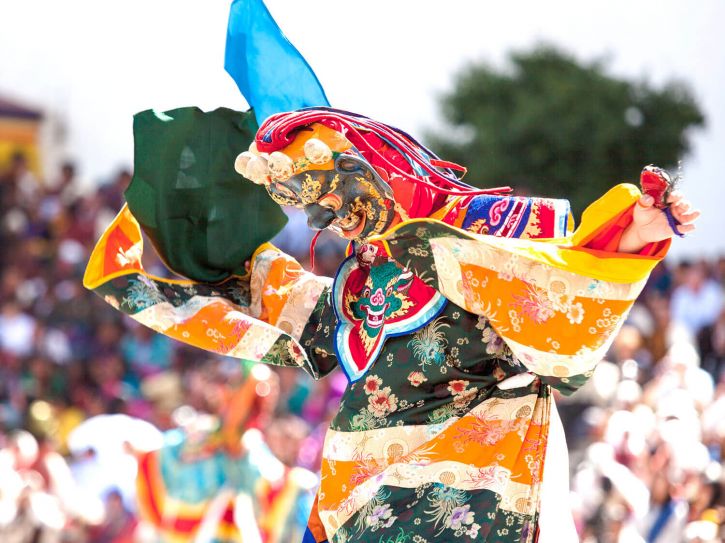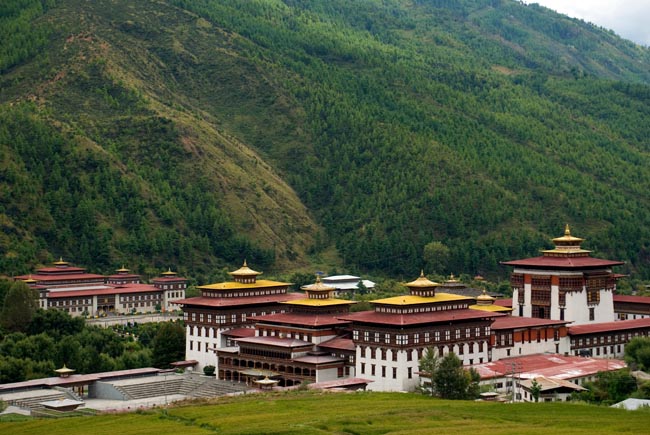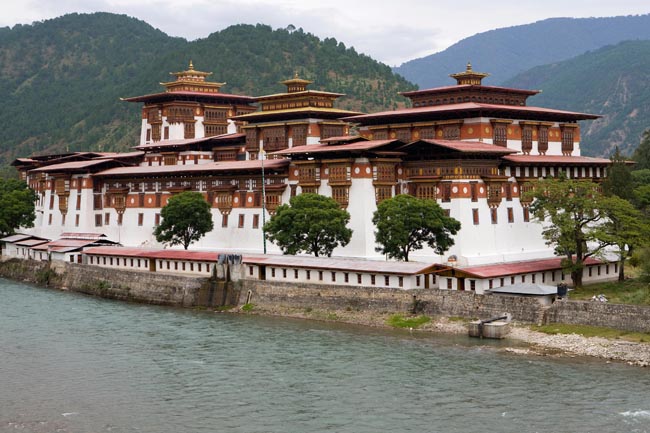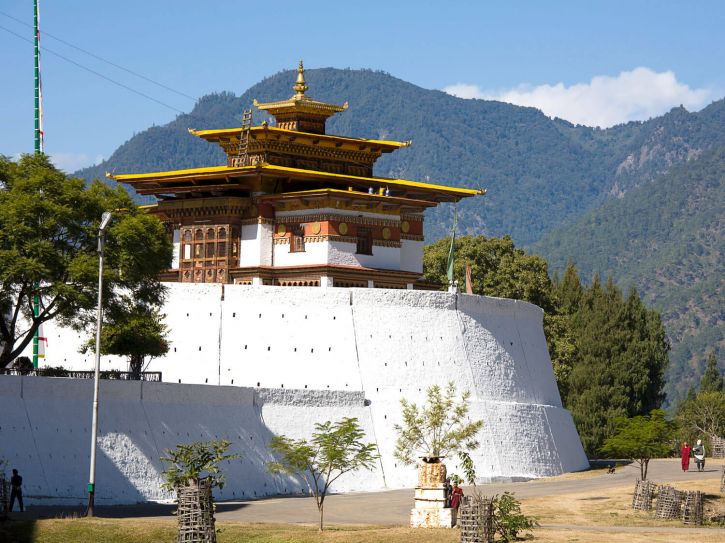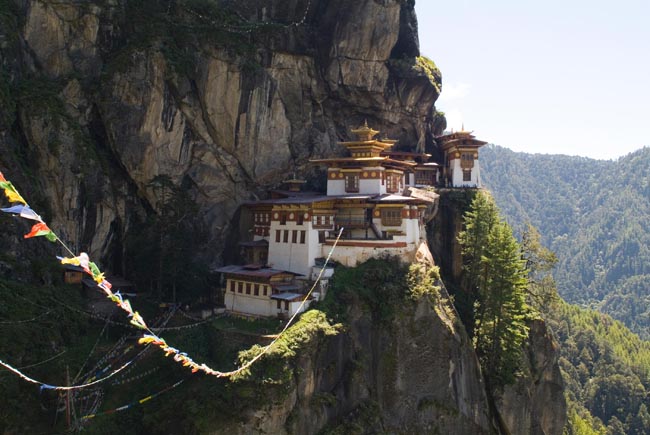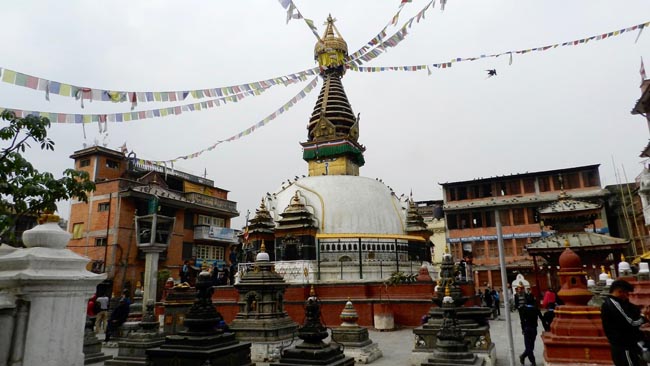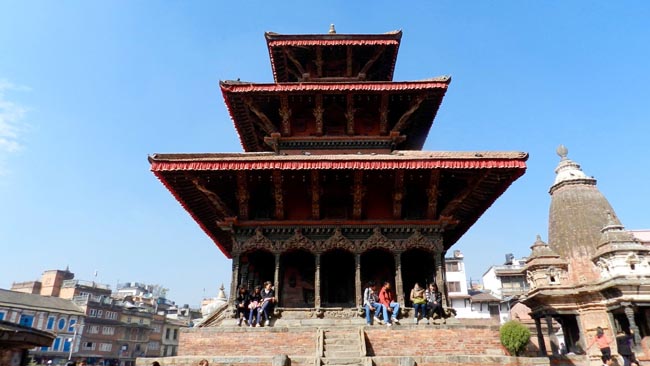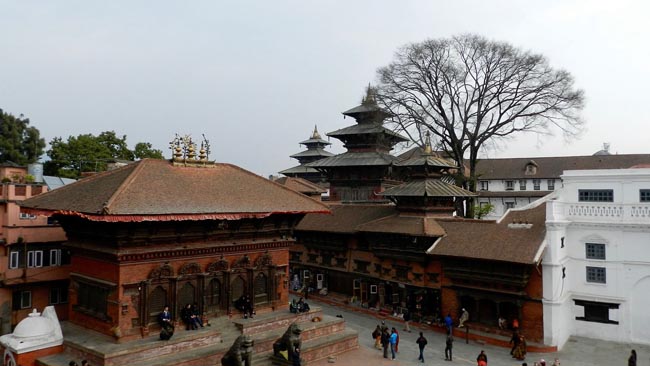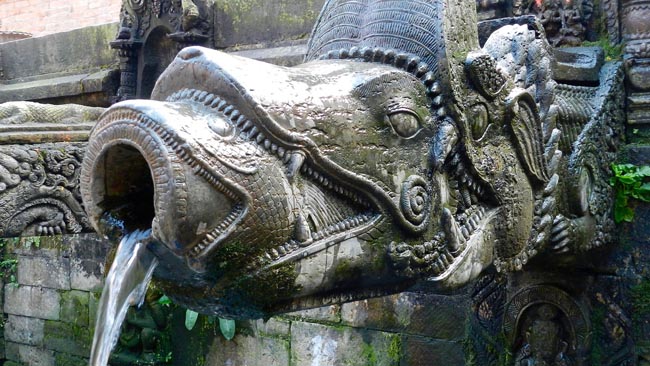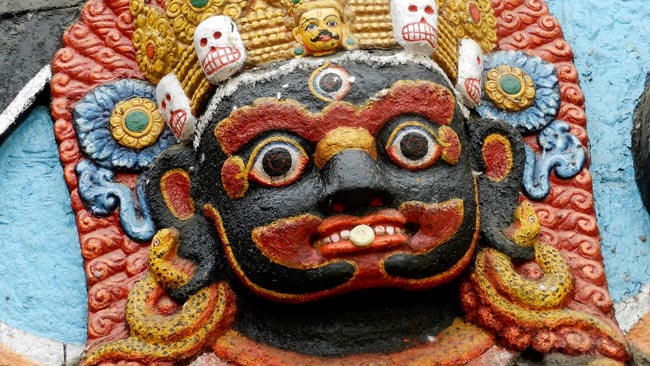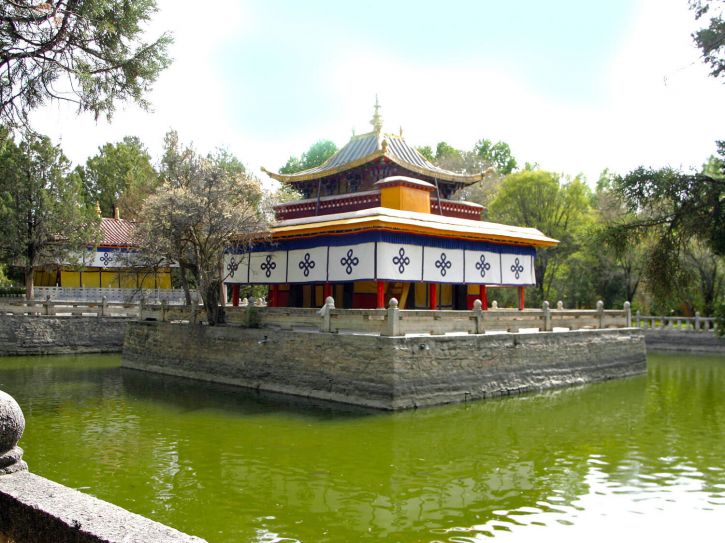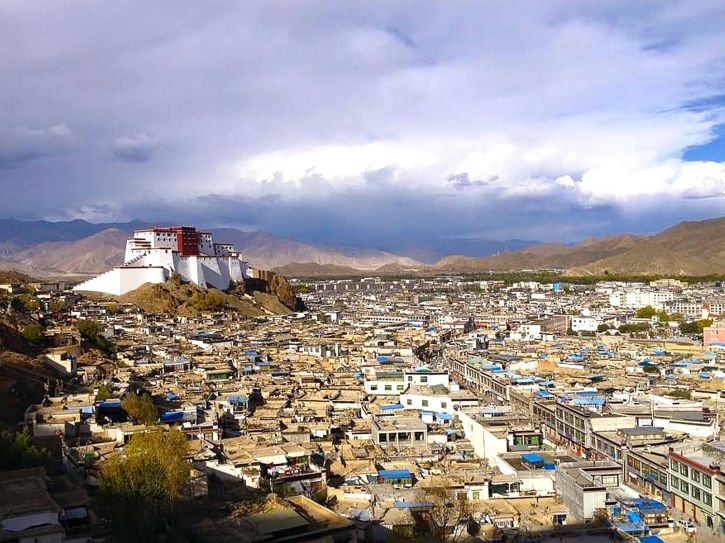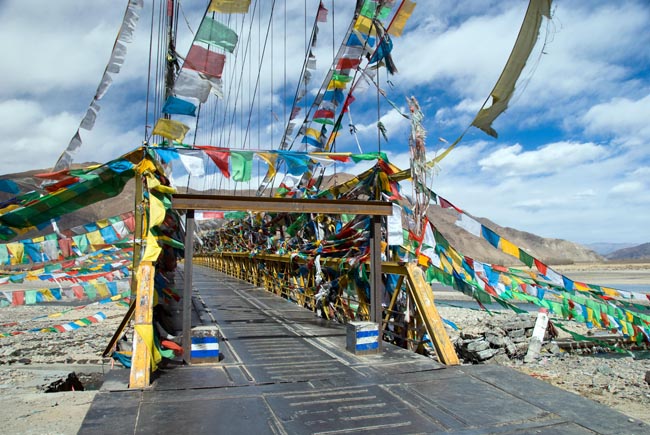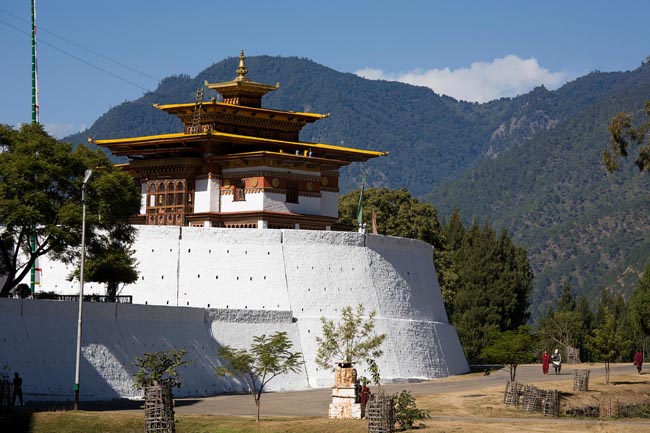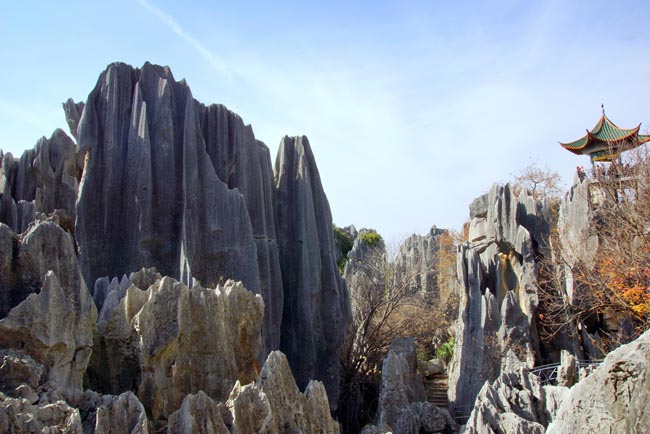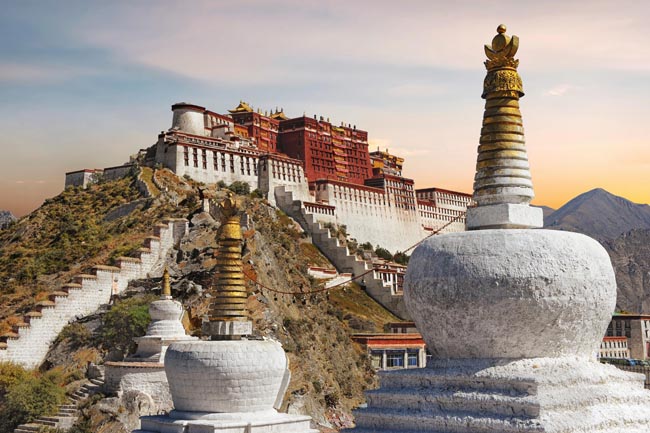On our Highlights of Himalaya tour you'll discover mystery, beauty, and tradition are ingrained into the great lands of the Himalaya. Tibet is wonderfully rich in natural beauty and tradition.
Often referred to as the "Roof of the World", this is a place both mystical and spiritual. While the ancient monasteries of Tibet emit a calming peace, Kathmandu hums with the life of its people.
Wedged between the high Himalaya and the steamy Indian plains, Nepal is the very watershed of Asia.
Nepal's cultural landscape is every bit as diverse as its physical one. Its peoples belong to a host of distinctive ethnic groups, and speak a host of languages.
Massive mountains, golden temples, fluttering prayer flags, Buddhist stupas, wild yaks, and wonderful people, Nepal really has it all.
Bhutan is perhaps the most exclusive destination in the Himalayas, a land of deep valleys and dzong (fortresses) perched on precarious peaks, this is one of the most isolated and least-developed nations in the world.
The breathtaking beauty, combined with the warmth and friendliness of the locals is what draws many to Ladakh. This is a land of jagged mountains, picture-perfect gompas (Tibetan Buddhist monasteries),and iconic colourful prayer flags.
Prices below are per person, twin-sharing costs in US Dollars (USD). Pricing does not include airfare to/from the tour and any applicable taxes. For single supplement rates and taxes (if any), please refer to below Prices & Dates table. For general information on flights to/from the tour, click here.
Your Travel and Accommodation Arranged For You
Tips Included for Driver, Restaurant Staff, Local Guides
Authentic Local Experiences With Lots Of Inclusions.
Select a date below to reserve your spot:
Due to the nature of internal flights, this tour requires a $1000 per person deposit. Due to Bhutan festival dates that are announced closer to departure, our 2025/26 dates are TENTATIVE and could shift slightly.
Optional Single Supplement: $1850 USD (number of singles limited).
This tour may require a mandatory single supplement charge of $1390 if you join our share program and we are unable to pair you.
Download Itinerary
Day 1 Arrive in Delhi
Today we arrive into the pulsating metropolis of Delhi.
Despite its recent metamorphosis into a cosmopolitan hub for global business, media, technology, and fashion, Delhi is also a surprisingly green city, with whole swaths given over to gardens, parks, and protected woodlands. This city is the true hub of the country, and a symbol of India old and new!
Overnight in Delhi (airport area hotel).
Included Meal(s): Dinner
Day 2 Delhi - Leh, Ladakh: Orientation Tour
Early this morning we fly up to Leh (3524 m / 11,562 ft). This surely is one of the most sensational scheduled flights in the world, taking you right over the top of the Greater Himalaya before dropping down to the small airport at Leh. The breathtaking beauty, combined with the warmth and friendliness of the locals is what draws many to Ladakh. This is a land of jagged mountains, picture-perfect gompas (Tibetan Buddhist monasteries) and colourful fluttering prayer flags!
Leh is very Tibetan in many respects; the national dress, 'stove-pipe' hats and felt boots with turned-up toes are much in evidence. The Royal Palace which dominates the town is very reminiscent of the Potala in Lhasa and Tibetan Buddhist monasteries, large chortens, prayer flags and mud brick houses with flat roofs are a dramatic culture change from the hot, teeming frenetic rush of Delhi.
The balance of the day is flexible due to the dramatic change of altitude and the importance of acclimatization. Your Tour Leader will likely suggest an easy orientation walking tour to Leh's colourful markets and central hub.
Note: The actual order of Leh area sightseeing may vary due to weather and other logistical considerations. Your day-by-day sightseeing may be modified at the discretion of your Tour Leader, with Leh area sightseeing spaced out to take into account the sudden change in elevation.
Overnight in Leh.
Included Meal(s): Breakfast and Dinner
Not finding what you're looking for?
Our specialists can take away the stress and create a private custom tour tailored to your exact interests and budget.
Day 3 Leh: Alchi & Likir
Today's sightseeing features an excursion across the arid and high plateau to Alchi, one of the largest ancient monastic complexes and an important Buddhist centre in all of Ladakh. Founded in the 11th century by Rinchen Zhangpo, one of the early Tibetan preachers who spread Lamaistic Buddhism to this part of the world, Alchi is undergoing major restoration work under UN sponsorship. The 1000-year-old paintings inside the main temple are some of the oldest of their kind and quite distinct from the murals present in the later built gompas.
On our return to Leh we will stop to see the location where the grey waters of the Indus meet the blue waters of the Zanskar River flowing from the remote Zanskar region of the Greater Himalaya. We will also visit Likir Gompa set on an isolated ridge. This magnificent gompa, overlooking the village of Likir, was founded in the 14th century and belongs to the Yellow Hat Sect. The head lama here is the younger brother of the Dalai Lama.The Likir Gompa is one of the oldest and well maintained monasteries in the Ladakh district.
Overnight in Leh.
Included Meal(s): Breakfast and Dinner
Day 4 Leh & Hemis Gompa
Early this morning we head east along the Indus Valley toward Hemis Gompa, dramatically hidden in a cleft the mountains. Hemis Gompa is located around 50 kms away from Leh on the west bank of Indus River, and it is regarded as the wealthiest and biggest monastery in Leh. Here we find a gigantic thangka, one of the largest in the world, and the largest and one of the most important in Ladakh. It was founded about 350 years ago by Stagtshang Rinchen, who was invited to Ladakh by King Singe Namgyal, founded it about 350 years ago.
Along our route back to Leh we will make a stop at Stok Gompa which dates back to the 14th century. Hidden behind a screen of trees around 2km south of the palace, Stok's small monastery has some crumbling old stupas, but the dominant feature, 200m above, is its brand-new gilded Buddha that is visible from most of the village. As we enter the veranda of the monastery, we come across bright friezes depicting the Guardians of the Four Directions. One of the major attractions of the Stok Monastery is its library, which boasts a complete set of the Kandshur, the 108 volumes of the Buddha's teachings.
Overnight in Leh.
Included Meal(s): Breakfast and Dinner
Day 5 Leh: Palaces & Gompas
Today we'll have a jeep tour up the hairpins of the Nubra Valley road to the Khardung La Pass (5470 m/18,400 feet) -- the highest vehicular accessible pass in the world (inaccessible in spring due to snow). The views of the Zanskar Range and the Indus Valley on the way up are amazing as are frequent sightings of yaks on the high pastures below the pass. The road to the pass that crosses the Ladakh Range and provides access to the Nubra Valley and the Karakoram region was built at great human and financial cost by the Indian Army following frequent incursions into the area by the Chinese Army following the occupation of Tibet in the late 1950's.
Later we embark on an exploration of Leh Palace, a striking historical structure perched on a hill overlooking the town of Leh. Built in the 17th century by King Sengge Namgyal, this palace served as the royal residence until the 1830s. The palace's design, a blend of Tibetan, Indian, and Mughal influences, features nine stories with the upper floors housing the royal family and the lower floors used for stables and storerooms. The exterior, made of sun-dried bricks and wooden frames, reflects traditional Tibetan-style architecture with its sloping walls and narrow windows.
Inside, we wander through deserted halls that once buzzed with royal life. The murals, though faded, offer glimpses into the past, depicting religious motifs and scenes from Ladakhi culture. Currently, UNESCO is restoring Leh Palace, aiming to preserve its historical authenticity. We observe these efforts and appreciate the dedication involved.
From the upper floors and balconies, we enjoy panoramic views of Leh and the surrounding landscapes, providing a unique perspective on the town and its strategic importance.
Overnight in Leh.
Included Meal(s): Breakfast and Dinner
Day 6 Leh - Delhi
Today we fly from Leh back to Delhi. If time permits, we will enjoy some sightseeing in Delhi this afternoon.
Overnight in Delhi (likely an airport area hotel).
Included Meal(s): Breakfast and Dinner
Day 7 Delhi, India - Paro, Bhutan - Thimphu
Today we fly to Bhutan. Our flight brings us into Paro, and this journey is considered to be one of the most thrilling descents as the plane glides into the valley. One can see the red chillies drying on farm roofs nearby, and the crisp mountain air greets all visitors.
Upon arrival we will drive to Thimphu (2320 m/7,609 feet), the capital, which is roughly an hours' drive from the airport. En route we will see the Iron Bridge Builder Monastery located in the opposite hillside. You will also cross the Chunzom (confluence of rivers) bridge where stupas in three styles (Bhutanese, Nepalese and Tibetan) are located.
Thimphu is a bustling developing city/town with little cafes, bookshops and handicraft shops lined along its streets. The main town center itself is just a small area, and it lends itself well to individual exploration as it is easy to walk around and navigate. This town of about 100,000 people built along traditional lines is the administrative centre of Bhutan and was only established in the 1950s.
Overnight in Thimphu.
Included Meal(s): Breakfast and Dinner
Day 8 Thimphu Area & Annual Festival
Today we drive to the impressive Tashicho Dzong (which we may be allowed to enter), the traditional summer capital of Bhutan and now the seat of the Bhutanese government. The present building is a rebuilt version of a dzong or monastery-fortress that was erected here by Nawang Namgyal in 1641 and it retains many of the features of the old dzong. It is now an impressive sight and it houses all the government deparments and ministries, the throne room of the King, the National Assembly chambers and the nation's largest monastery with over 2,000 monks in residence.
OUR DEPARTURE coincides with the Thimphu Tsechu, an annual festival held at the Tashi Chhodzong. The Tsechu reflects the deeply rooted religious sentiments of the people. For three days various types of masked dances are performed. Many depict the story of good triumphing over evil, the day of 'judgmentmatrimonifidelity.' Please note that occasionally we include a festival in another location should the announced dates, which can vary a lot from year to year, not be optimal for our visit (ie in terms of weather). The overall experience does not vary from festival to festival as they all operate on a similar concept with similar ceremonies, costumes and customs.
Overnight in Thimphu.
Included Meal(s): Breakfast, Lunch and Dinner
Day 9 Thimphu - Punakha
This morning we depart Thimphu via the spectacular Dochula Pass 3031 m (10,004 feet). We pass steeply through a forest of pine and cedar with panoramic views of the Himalaya (Thimphu-Punkaha 77 km/48 miles, 3 hours).
Today's journey takes us deep into the heart of Bhutan. The drive will give you an insight into a medieval way of life that has changed little over the centuries. Modern development has brought better education, health care and electricity to these remote areas but the local small farm-based economy that has kept the local people self sufficient over the years is largely unchanged. Located at a relatively low altitude of 1300 m (4,265 feet) in a rainshadow, the Punakha Valley produces most of the oranges and fruits grown commercially in Bhutan. Despite the warmer climate and the possibility of growing an endless variety of produce, the population of the valley remains remarkably low. Until very recently, Punakha remained the winter capital of Bhutan (there is only one capital now, Thimphu), and it is still the winter headquarters of the Head Abbott (Je Khempo) and his monks who move here every winter.
Upon reaching Punakha we will visit the Punakha Dzong, arguably the most beautiful dzong in the country! The magnificent Punakha dzong straddles an island in the confluence of the Pho Chu and Mo Chhu (male and female tributaries of the river). This dzong was the second to be built in Bhutan and it served as the capital and seat of government until the mid-1950s. All of Bhutan's kings have been crowned here. The dzong is still the winter residence of the dratshang (official monk body). Today the dzong has been magnificently restored to befit its status in Bhutan’s history.
Overnight in Punakha.
Included Meal(s): Breakfast, Lunch and Dinner
Day 10 Punakha - Paro & Paro Dzong
Today we travel by road back to Paro, set in what is considered to be the most beautiful of the main valleys (2280 m / 7,500 feet). The dominant feature of Paro is undoubtedly the Paro Dzong set above the glacial Paro Chu River. It is a particularly important and historic dzong having played a part in Bhutan's history since it was first constructed.
Paro is a thriving agricultural valley and is also the location of some of the holiest Buddhist sites in Bhutan. Before the construction of roads most of Bhutan's trade came through Paro either from Tibet via Tremo la or from the south via Haa. Paro Valley extends from Jumolhari on the Tibetan border to Chuzom which is the confluence of the Thimphu and Punakha rivers.
The town is an interesting mix of traditional architecture interspersed with handicraft stores, cafes and galleries. This morning we can stroll and explore the growing town. The town is situated below the Dzong, which overlooks the valley and is accessible via a traditional cantilever bridge. Near the bridge are chortens (prayer shrines) situated alongside the Ugyen Pelri palace. We will also visit the local monastery situated at one end of the town. If we are lucky we may be able to view an archery match as the local archery field is at the end of the town en route to the Ugyen Pelri Palace.
Overnight in Paro.
Included Meal(s): Breakfast, Lunch and Dinner
Day 11 Paro: Area Sightseeing
Today we will continue with our sightseeing in Paro. Just a short drive from town is the revered Kyichu lhakhang, one of Bhutan's oldest and most beautiful temples situated among the paddy fields. This is venerated as being as holy as the monastery in Lhasa. The small Dumste lhakhang was built in Tibetan style, and legend has it that it had flown from Tibet.
We will enjoy a visit to the Paro National Museum, situated above the Dzong in the ancient watchtower (at time of writing the exhibits are being viewed in an adjoining building as the tower is under repairs). Housed in a 17th Century watchtower, the museum has a unique character and beautiful panoramic views over Paro Valley. Opened in 1968, its collection of fine arts, paintings and bronzes are famous. Here we will also find displays of textiles, jewellery, and handicrafts. The top floor of the museum is a chapel containing a "tree" depicting the main figures of the four religious schools of Tibetan Buddhism. After our visit here we will visit the Rinpung Dzong which serves as the headquarters for the local government and the local monk body.
At some point in our Paro visit, we'll head up the valley to view the famed Takstang, or 'Tiger's Nest', monastery, which burned down in 1998. The monastery has been rebuilt and we will drive to a viewpoint in the valley from where we can see Takstang high up on the cliff opposite.
NOTE: If you are interested in hiking all the way up to view/visit the Tiger's Nest, please consult with your Tour Leader upon arrival on tour. The overall hike/visit will require a bus ride for a short distance and the hike itself takes 6-7 hours over steep terrain at approximately 2700m/9,000 ft. Your Tour Leader can provide more details on arrival and assist with arrangements (including a required special permit).
Overnight in Paro.
Included Meal(s): Breakfast, Lunch and Dinner
Day 12 Paro, Bhutan - Kathmandu, Nepal - City Touring
Today we fly from Paro to Kathmandu, Nepal.
Wedged between the high Himalaya and the steamy Indian plains, Nepal is the very watershed of Asia. Nepal’s cultural landscape is every bit as diverse as its physical one. Its peoples belong to a host of distinctive ethnic groups, and speak a host of languages. Massive mountains, golden temples, fluttering prayer flags, Buddhist stupas, wild yaks and wonderful people, Nepal really has it all.
Kathmandu, the capital, is a very liveable city, with pagodas dominating open squares and narrow alleys hemmed in by wooden buildings and fretwork screens. Here we can explore thousands of years of culture while making our way through historic temples and monasteries that belong to Hindus and Buddhists alike. At every turn you encounter rich culture, hidden temples, colourful bazaars, and the friendliest, warmest of welcomes.
After refreshment, we travel to Kathmandu's central meeting area, Durbar Square, a profusion of temples reflecting the different architectural styles dating from the eleventh century. Kathmandu’s Durbar Square was where the city’s kings were once crowned and legitimized, and from where they ruled. The Durbar Sq area is actually made up of three loosely linked squares, and the area also includes the Royal Palace with its gilded gates and elaborate statues. The square is alive with a multitude of nationalities, intermingled with stalls displaying a wide variety of Nepalese and Tibetan handicrafts.
We then proceed to Swayambhunath Temple, Nepal's most significant centre of Buddhist worship. A journey up to the Buddhist temple and UNESCO World Heritage Site of Swayambhunath is one of the definitive experiences of Kathmandu. There has been a temple on this site since at least the 5th century. Swayambhunath is also known as the "Monkey Temple" due to the large population of monkeys that make the grounds their home. The temple buildings are set atop a hill and offer an excellent view of Kathmandu and its valley.
This afternoon we will visit Patan, the second largest town in the Kathmandu valley. Patan is merely 5 km away from the capital city, but, despite such proximity, its 'preserved' ancestral uniqueness distinguishes Patan as a different environment. Patan’s Durbar Square contains some of the finest examples of Newari Architecture in Nepal.
Please note: Early in our visit to Nepal, we will be putting the final bureaucratic touches on our Tibet permits through the Chinese Embassy in Kathmandu. We'll have to complete some forms and such, and then over the next days, our documents will be finalized. This takes at least three days, so while we wait we'll make the most of our stay!
Overnight in Kathmandu.
Included Meal(s): Breakfast and Dinner
Day 13 Kathmandu - Bhaktapur & Kathmandu Valley - Nagarkot
Today we will explore the historic suburb of Bhaktapur, designated as a UNESCO World Heritage Site. Founded in the 12th century, Bhaktapur is filled with Hindu and Buddhist religious sites and art. The tragic earthquake of 2015 caused terrible devastation, with whole streets of traditional houses lost to the disaster. Though only a few temples were destroyed, the scars of the disaster are still clearly visible and it will take years for the city to fully recover.
In addition to a walking tour of Bhaktapur, we will explore some other sites in the Kathmandu Valley. Pashupatinath is perhaps the most important Hindu temple in Nepal, and one of the most important Shiva temples on the subcontinent. This temple draws numerous devotees from all over India each year. Bouddhanath is among the largest stupas in South Asia, and it has become the focal point of Tibetan Buddhism in Nepal. The white mound looms thirty-six meters overhead. The stupa is located on the ancient trade route to Tibet, and Tibetan merchants rested and offered prayers here for many centuries. When refugees entered Nepal from Tibet in the 1950s, many of them decided to live around Bouddhanath. They established many gompas, and the "Little Tibet" of Nepal was born. This "Little Tibet" is still the best place in the Valley to observe Tibetan lifestyle. Monks walk about in maroon robes. Tibetans walk with prayer wheels in their hands, and the rituals of prostration are presented to the Buddha as worshippers circumambulate the stupa on their hands and knees, bowing down to their lord.
Our destination today is Nagarkot, which will place us well for our morning activities.
Overnight in Nagarkot.
Included Meal(s): Breakfast and Dinner
Day 14 Nagarkot Sunrise & Chandragiri Hill
Today we rise early to see the sunrise over the Himalaya! Nagarkot is popular hill station located east of Kathmandu city, and the viewpoint tower is located at altitude of of 2195 meters. This setting provides one of the best panoramic views of 8 mountain ranges, stretching from Annapurna in the west to Makalu in the east. If weather is very clear, you may also see Mount Everest from this point. Weather-permitting, we hope to view the Central Himalayan ranges, which include the Langtang and Rolwaling ranges.
On our drive back to Kathmandu this afternoon, we'll take a trip up Nepal's newest cable car, taking us up Chandragiri Hill for the some more impressive views of the snow capped Himalaya anywhere. Opened in 2016, this exciting experience takes us on a 10-minutes journey to the top where you can see a panoramic view of the Mighty Himalayas. We will spend some time here to enjoy the setting before the return trip down to the mountain.
This afternoon you will have some free time in Kathmandu.
Overnight in Kathmandu.
Included Meal(s): Breakfast and Dinner
Day 15 Kathmandu, Nepal - Lhasa, Tibet
Today we fly to Tibet!*
This remarkable trans-Himalayan flight takes us directly past the Everest group of peaks. In a little over one hour, the Kathmandu-Lhasa flight covers rugged terrain that once took trade caravans months to cross. On a clear day as many as eight of the world's fourteen 8000+ m (26,000+ feet) peaks can be seen. The landscape changes dramatically as we cross the great barrier of the Himalaya, from Nepal's green terraced hillsides to the high and dry, barren plateau typical of Tibet. We fly over deep-blue Yamdrok Lake to land at Gonggar Airport, 85 km (53 miles) south of Lhasa.
Upon arrival we drive along the flat valley of the Tsangpo River to our hotel in Lhasa (3650m/12,045 feet). The balance of the day is left free so that our travellers have the chance to acclimatize to the high altitude.
Referred to as the "Roof of the World", Tibet is a place both mystical and spiritual. Entering Tibet you feel as though you've entered an entirely different world.
* Occasionally we are forced to fly to Lhasa tomorrow morning due to changeable flight schedules. If this happens, we will add sightseeing in Nepal for today (ie Old Town of Kirtipur, Khokana, and Bungmati) and shuffle some things in Tibet so that none of our listed sites are missed. As this situation often pops up at late notice, your Tour Leader will brief you of the situation, if applicable, while on tour.
Overnight in Lhasa.
Included Meal(s): Breakfast and Dinner
Day 16 Lhasa: Jokhang Temple & Barkhor
We start our day with a visit to Jokhang Temple, the religious and geographical centre of Lhasa. Jokhang is the most important temple in the world for all sects of Tibetan Buddhism. Pilgrims from across Tibet, many of whom have walked hundreds of kilometres to see the Jokhang once in their lives, line up for hours in order to enter the temple and perform a ritual circuit in prostration of its many sacred shrines. It is a moving experience to join them in the dark hallways, filled with the sound of low chanting, lit only by butter lamps. The main image worshipped here is Jowo Rinpoche, a gilded statue of Buddha Sakyamuni said to have been modeled during his lifetime.
The Jokhang is encircled by the Barkhor, an 800m (2,645 feet) flagstone pathway that is both a sacred circumambulation route and the biggest bazaar in all of Tibet. Night and day, Tibetans walk clockwise around it, earning religious merit as they shop, people-watch and chat with friends. Here you find people from all corners of Tibet: striking, tall Khampa men from the east with big knives and red tassels wrapped about their heads; Golok women with their hair plaited in 108 tiny braids; nomad families bundled in sheepskins. The Barkhor is the real heart of Tibet!
Overnight in Lhasa.
Included Meal(s): Breakfast and Dinner
Day 17 Lhasa: Potala Palace & Sera Monastery
This morning we visit the magnificent Potala Palace! Once the seat of the Tibetan government and the winter residence of the Dalai Lamas, the Potala Palace is Lhasa's cardinal landmark. The first recorded use of the site was in the 7th century AD, but it did not reach its full glory until the 17th century reign of the Fifth Dalai Lama. The 13 storey Potala rises 117m (383 feet) high and is made entirely of wood, earth and stone with over 1000 rooms. This is an architectural wonder even by modern standards.
This afternoon we will visit Sera Monastery, one of the most important Gelugpa (Yellow Hat sect) monasteries. Located at the foot of Tatipu Hill in the northern suburb of Lhasa City, Sera Monastery is one of three famous monasteries in the city along with the Drepung Monastery and the Ganden Monastery. This monastery is the location of the famous ‘monk's debate' which takes place on some afternoons during the week. During this ritual 'question and answer' session, a senior monk quizzes a junior and there is much grimacing, clapping and mock threatening. The important part of this ritual is the passing on of knowledge of the theosophical questions of the Tibetan lamaistic Buddhist faith. Though it seems pretty entertaining to the visitor, the debate rituals are serious business
and an important part of the training of these monks.
Overnight in Lhasa.
Included Meal(s): Breakfast and Dinner
Day 18 Lhasa: Drepung Monastery & Norbulingka
This morning we will visit Drepung Monastery, located at the foot of Mount Gephel. Dating back to 1416, this was once the largest monastery in Tibet, and during its peak there were over 10,000 monks living here. Today Drepung houses about 700 monks and attracts pilgrims and visitors from around the world. With numerous mansions and zigzagging alleys, the monastery looks like an impressive city in itself. Both Drepung and Sera suffered damage in varying degrees during the turbulent days of the Red Guards and their Cultural Revolution but have now been restored and the monks have returned.
This afternoon we will visit the Norbulingka, the Dalai Lama's summer palace and currently the site of a simple museum. Norbulingka means “Treasure Garden” in the Tibetan language. First built in 1751, it borrowed architectural styles from the inland areas of China while maintaining local ethnic and religious features. Norbulingka served as a traditional summer palace and residence starting with the 7th Dalai Lama, and now it is the largest garden in Tibet.
Nearby is the Tibet Museum, the first modern museum in Tibet. This museum houses a rich collection of prehistoric cultural relics including statues, imperial jade seals, gifts granted by emperors, colourful tangkas, and various printed Sanskrit and Tibetan scriptures. Here we can also see a variety of folk art such as unique Tibetan handicrafts, costumes, jewellery, and adornments made of gold, silver, and jade, as well as fine Chinese pottery.
Overnight in Lhasa.
Included Meal(s): Breakfast and Dinner
Day 19 Lhasa - Gyantse - Yamdrok Tso Lake - Shigatse
An early departure takes us from the high Tibetan plateau to Shigatse.
We pass colourful rock carvings of Buddha as we approach the outskirts of Lhasa at the start of a long road journey. We leave the city limits and follow the course of the Tsangpo River which, entering India, becomes the Bramahputra. From the Kamba La (Gampala Pass) at 4794 m (15,728 ft) there is a spectacular view of the blue waters of Yamdrok-Tso (4400m), one of Tibet's sacred lakes. The Lake is surrounded by many snow-capped mountains, and in the distance you can have spectacular views of Holy Mount Nyenchen Khangsar (7191m), the highest mountain near Lhasa.
We then travel the zigzag road to cross the mighty Yarlung Tsangpo River on our way to Lhasautra. The road then drops down to Yamdrok Tso Lake and follows the twisting northern bank for hours, prior to climbing up to the Karo La Pass. On either side are gigantic peaks including 7260 m (23,958 foot) high Nazin Kang Sa.
As we continue on our way to Shigatse, we will stop and visit Gyantse, famous for its multi-tiered stupa known as the Kumbum. The sprawling compound in the far north of town houses Pelkor Chöde Monastery and the monumental Gyantse Kumbum, a chörten filled with fine paintings and statues. Both are deservedly top of the list on most travellers' must-sees. Palkhor lies at the foot of Dzong Hill, and is well-known for its Kumbum, which has 108 chapels in its four floors. The multi-storied Kumbum Stupa is crowned with a golden dome and umbrella, surrounded with more chapels filled with unique religious statues and murals.
We later arrive in the city of Shigatse (3900 m/12,870 feet), the second largest city in Tibet and the seat of Pamchan Lama.
Overnight in Shigatse.
Included Meal(s): Breakfast and Dinner
Day 20 Shigatse Area Sightseeing
Today we will visit the main site of interest at Shigatse, the Tashilhunpo Monastery. Located on a hill in the center of the city, the full name in Tibetan of the monastery means "all fortune and happiness gathered here"
Standing at the entrance of Tashilhunpo, we will see the grand buildings with their golden roofs and white walls. The remarkable Thangka Wall, which is nine floors high, was built by the First Dalai Lama in 1468. The images are so large that one can easily see them from Shigatse City. The main structures found in the monastery are Maitreya Chapel, Panchen Lama's Palace and Kelsang Temple. Tashilhunpo has been the seat of the Panchen Lama -- the second most important spiritual leader of Tibet -- since the Fourth Panchen Lama took charge in the monastery. There are now approximately 800 lamas here.
Overnight in Shigatse.
Included Meal(s): Breakfast and Dinner
Day 21 Shigatse - Lhasa
Today we re-trace our steps back to Lhasa for our final night in Tibet.* Traveling by road from Shigatse to Lhasa offers a truly immersive experience, allowing you to connect with the Tibetan landscape and culture in a way that is impossible to achieve by other means.
* We do not end our tour in Lhasa as visa rules require that all group members depart Tibet (China) on the same flight/same day.
Overnight in Lhasa.
Included Meal(s): Breakfast and Dinner
Day 22 Lhasa, Tibet - Fly to Kathmandu, Nepal
Today we fly back to Kathmandu to connect to homeward flights.
This evening we convene for our farewell dinner.
Overnight in Kathmandu.
Included Meal(s): Breakfast
Day 23 Departure
Departure from Kathmandu.
BON VOYAGE!
Included Meal(s): Breakfast
Inclusions
Breakfast and dinner are included daily; all meals included in Bhutan.
Evening meals on tour will be taken mostly at hotels.
In some locales we endeavour to break up the buffet dinners with a meal at a local restaurant but, overall, the imperatives of hygiene and quality dictate hotel meals.
All transport, accommodation, sightseeing and entrance fees are included for sites noted as 'visited' in the detailed itinerary.
Gratuities for drivers, restaurant staff, porters, local guides.
Airport transfers for land & air customers.
Exclusions
International airfare to/from the tour.
Tour Leader gratuities, lunches in India, Nepal, and Tibet; drinks, personal items (phone, laundry, etc), domestic and international (if applicable) air taxes, visa fees, and any excursions referenced as 'optional'.
Airport transfers for Land Only customers (our start hotel near Delhi Airport likely provide shuttle service).
Optional trip cancellation insurance.
Our post-reservation trip notes offer further guidance on shopping, not included meals, visas.
"Visa Fees" are not included in the tour cost; we list these separately as they can change without notice (approx US$300). For this tour, these include the cost of your Bhutan pre-clearance and Tibet permit.
Seasonality and Weather
As most of this tour occurs at medium-high elevations, we can expect cool-cold temperatures overall. The only warm/hot locations are Delhi and Nepal, which are much lower and more temperate. That said, weather conditions can be highly-changeable throughout, and one should be prepared for a wide range depending on altitude, shelter from wind, time of day, and whether or not the sun is shining!
NEPAL: The Kathmandu Valley, at an altitude of 1310m (4,297 ft), has a mild climate, ranging from 17-23C (64-76F) in the fall.
LADAKH & TIBET, due to their its unique geographical characteristics, are cold in winter, cool in summer and early fall, and generally dry. Sunlight is extremely intense. The thin air neither blocks nor holds heat so sunshine feels warm, shadows chilly, and temperatures can vary greatly within a day. Rainfall occurs intermittently between May-Sep, bringing moisture to barley fields and greenery to the valleys. The most pleasant months for tourism are from Mar-Oct.
BHUTAN: The Monsoon occurs between Jun & Aug. Outside that time days are usually very pleasant (15C/60F) with clear skies and sunshine. Nights are cold. Oct/Nov is the best time to visit -- rainfall is at a minimum and temperatures are conducive to active days of sightseeing.
YOU WILL EXPERIENCE TEMPERATURE EXTREMES ON THIS TOUR. BE PREPARED FOR INTENSE SUN AND SOME CHILLY CONDITIONS.
Our departures coincide with a festival in Bhutan (actual festival chosen for our tour can vary from year-to-year). The Tsechu (festival) reflects the deeply rooted religious sentiments of the people. Various types of masked dances are performed. Many depict the story of good triumphing over evil, the day of judgment, matrimonial fidelity etc.
Transport and Travel Conditions
Land transportation is via private bus or Land Cruiser type vehicle depending on group size and/or conditions. Air-conditioning/heat in vehicles is generally not available in this part of the world. Road conditions are generally quite poor and can be bumpy, and as with all mountain roads the occasional delay can occur due to landslides or adverse weather conditions. The roads are also quite twisty on the mountain sections.
Internal flights via scheduled carriers. Porters are generally available at hotels but you must be able to manage with your baggage at airports.
Though we usually reserve our Difficulty Category 3 rating for our "active" series of tours that include extended hiking/trail walking, our level 3 rating for this tour refers to our moderately strenuous activities and the fact that it is very busy: you must be prepared for some early starts, be steady on your feet, and be able to endure some heat/cold and long travel and sightseeing days at high altitudes. We have numerous walking tours and visit several sites that are LARGE with lots of steps and uneven surfaces.
ALL PASSENGERS are required to complete a simple medical self-assessment questionnaire attesting to your fitness for this journey. Those with pre-existing conditions that could be exacerbated by travel at high altitude or on poor roads, or persons with compromised immune systems and mobility problems, should carefully consider their participation.
Am I suitable for this tour? Please refer to our self-assessment form.
Activity Level: 3
These tours are considerably more strenuous than our Level 1 & 2 "cultural" tours and feature walks/hikes on undulating and uneven pathways for 3-7 hours at a leisurely pace. We don't hike every day, but participants should be fit and active and accustomed to trail walking, possibly in remote locations, and be prepared to engage in a conditioning regimen prior to the trip. Altitude may also be a factor on some tours, though none of our hiking tours currently occur above 3000m/10,000 ft. These are hotel-based tours with no camping, and you are required to only carry what you need for the day.
To learn more about the Activity levels, please visit our tour styles page.
Accommodation
We will be staying in hotels with private bathrooms, and there will be hot water, though in more remote areas this may only be available in the morning and evening. Few of the hotels are centrally-heated, although coal fires can sometimes be provided in the bedrooms.
Generally hotels are comfortable and often spectacularly-located, though simple with quirks that can range from charming to frustrating.
Single rooms are limited and possibly smaller than twins. Porters are generally available (see 'Inclusions').
Staff and Support
Tour Leader throughout, local drivers, local guides at various locations.
Group Size
Maximum 18 plus Tour Leader
*The red tour trail on the map does not represent the actual travel path.
The following is a list of sample hotels at some locations included on this tour. The hotels shown here are meant to provide a general sense of the standard of hotel we usually aim for; they are not necessarily confirmed for your chosen departure.



Located on Old Fort Road, the hotel is at a two minutes walk from the main bazaar of Leh and about 5Kms from the Airport.
We welcome you for a pleasant stay with us.


Hotel Phuntsho Pelri offers multi-cuisine restaurant and bar, a well-equipped business center, free Wi-Fi, a coffee shop, a conference room, a saloon, and spa facilities are all available at this hotel Phuntsho Pelri in the center of Thimphu.














